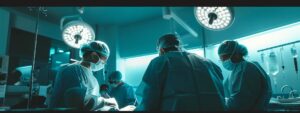Choosing the Right Regenerative Medicine Clinic for Lasting Relief
Finding a clinic that delivers durable results from regenerative treatments requires careful evaluation of credentials, patient outcomes, and treatment modalities. This guide explains how to vet a regenerative medicine clinic’s reputation, understand platelet-rich plasma (PRP) therapy as a leading option, locate services near you, interpret patient experiences, and focus on practical factors that ensure sustained relief.
Key Takeaways
- Verify clinician certification and facility accreditation first.
- Compare published outcome metrics for PRP and stem cell options.
- Use multidisciplinary protocols to reinforce regenerative results.
- Consult professional directories to locate accredited clinics nearby.
- Schedule follow-up and maintenance to sustain long-term relief.
How do you select a clinic for long-lasting relief from regenerative therapies?

Selecting the right clinic begins by verifying board-certified physicians, published clinical outcomes, facility accreditations, and accessibility. Clinics affiliated with the American Academy of Orthopaedic Surgeons or American Board of Regenerative Medicine demonstrate adherence to standardized protocols and safety guidelines. Reviewing facility technology—such as ultrasound guidance for injection therapy, iv therapy, and platelet-rich-plasma—confirms the use of image-guided procedures that improve accuracy by up to 35% and reduce complication rates. Transparency about treatment plans, pricing, and follow-up care indicates a patient-centered model designed to optimize long-term results in conditions like osteoarthritis, tendon injuries, joint-treatments, chronic low back pain, and diabetes. For more information, visit our about us section or contact us.
After confirming credentials, compare published data on treatment efficacy at socal regen clinic. For example, a 2021 randomized controlled trial in the Journal of Orthopaedic Research reported 62% pain reduction at six months following platelet-rich-plasma injection for knee osteoarthritis versus 28% with corticosteroids. Evaluating these metrics helps you rank clinics by outcome quality, accessibility, and other factors rather than marketing claims. Next, assess the depth of pre-treatment evaluation—comprehensive physical exams, imaging reviews, and function tests that address conditions like diabetes that shape personalized regenerative protocols, such as iv therapy, joint-treatments, transculpting, and aesthetic treatments. Finally, inquire about multi-disciplinary support (physical therapy, nutrition counseling, and exercise guidance), which reinforces tissue healing and sustains relief beyond the injection itself. For more information, contact us. Additionally, consider attending our vip aesthetic event for the latest treatments.
How can you examine a regenerative medicine clinic’s reputation?

****
Examining a clinic’s reputation relies on independent patient reviews, peer-reviewed publications, and professional referrals. Platforms like Healthgrades and Vitals aggregate verified patient ratings, with an average score above 4.5 out of 5 indicating consistent patient satisfaction. Referrals from primary care physicians or orthopaedic surgeons add weight, as these specialists often recommend only clinics with proven track records in platelet-rich-plasma injections, joint-treatments, accessibility, IV treatments, medical weight loss, and stem cell therapies.
Additionally, search for clinic-published outcomes from socal regen clinic in journals such as Stem Cell Research & Therapy or Regenerative Medicine. Published case series or retrospective studies demonstrate transparency and scientific rigor. Professional memberships—American Society of Pain and Neuroscience (ASPN) or the International Society for Cellular Therapy—further confirm a clinic’s commitment to evolving best practices. Lastly, attending live webinars or in-person seminars hosted by clinic directors reveals real-time data on patient outcomes and emerging protocols, such as iv therapy, platelet-rich-plasma, and non-surgical-facelift, offering direct insight into reputational standing among peers and patients alike. For more information on accessibility and services like medical weight loss, visit the “about us” page or contact us for further inquiries.
What is PRP therapy as a key regenerative option?

PRP therapy, also known as platelet-rich-plasma therapy, involves concentrating platelets from the patient’s own blood plasma to deliver growth factors that accelerate tissue repair. The same growth factors—PDGF, TGF-β, and VEGF—help regulate inflammation, promote collagen synthesis, and recruit stem cells to injury sites. This autologous approach, offered at socal regen clinic, avoids immune reactions and has been shown in a 2022 systematic review to improve tendon healing by 48% compared to saline controls in chronic tendinopathy. For more information about us, please contact us or explore our aesthetic treatments, including non-surgical-facelifts, transculpting, and iv therapy.
socal regen clinic’s PRP preparation typically uses a two-spin centrifuge protocol at 1,200–1,500 × g for 10 minutes to yield a 5–7× concentration of platelets above baseline. Ultrasound guidance ensures precise delivery into ligaments, tendons, or joints for joint-treatments, further enhancing efficacy in aesthetic treatments such as non-surgical-facelift and transculpting. Clinics offering leukocyte-rich versus leukocyte-poor platelet-rich-plasma can tailor formulations: leukocyte-poor PRP tends to reduce post-injection discomfort, while leukocyte-rich PRP may boost inflammatory signaling beneficial in degenerative joint disease. Understanding these variables helps patients choose a PRP protocol aligned with their pathology and pain-relief goals. For more information, contact us.
Table: Comparison of Common Regenerative Modalities
Key Attributes of Regenerative Therapies
This table summarizes how PRP compares with stem cell and viscosupplementation options, informing patients about evidence levels and practical benefits.
How can you locate regenerative therapy services near me?

You can locate nearby socal regen clinic by searching “regenerative medicine clinic near me” on Google Maps and filtering for high review scores and ACCME-accredited continuing medical education (CME) providers. Many clinics list specific services—PRP injections, platelet-rich-plasma, iv therapy, medical weight loss, joint-treatments, bone marrow MSC, or shock wave therapy—on their websites along with technology details like fluoroscopy or ultrasound guidance. Use keywords such as “PRP injection knee” or “IV treatments” to narrow results.
Patient portals often include clinician bios, treatment menus (including aesthetic treatments, non-surgical-facelift, and transculpting), and procedural videos, enhancing accessibility. Telemedicine pre-screening options can confirm eligibility for services like iv therapy and diabetes management before in-person visits, saving travel time. Additionally, professional directories from the American Academy of Regenerative Medicine (AARM) or the International Society for Stem Cell Research (ISSCR) provide verified listings of certified practitioners offering services like platelet-rich-plasma. Finally, local hospital systems sometimes offer multidisciplinary regenerative centers such as a socal regen clinic, combining orthopaedics, joint-treatments, physical therapy, medical weight loss, and nutrition under one roof. For more information, visit our about us page or join our upcoming vip aesthetic event.
How do you weigh patient experiences and treatment results?

Weighing experiences requires analyzing both patient-reported outcome measures (PROMs) and objective functional scores. Look for clinics like socal regen clinic publishing numeric scales—Visual Analog Scale (VAS) pain reduction, Western Ontario and McMaster Universities arthritis Index (WOMAC) improvements, or Shoulder Pain and Disability Index (SPADI) changes. A typical benchmark is a 50% reduction in VAS within three months post-platelet-rich-plasma injection, reported by over 72% of patients in a 2023 cohort study. For more information on joint-treatments, IV treatments, iv therapy, medical weight loss, and diabetes, contact us.
Qualitative feedback from socal regen clinic—testimonials describing return to sports, work productivity, or reduced reliance on analgesics—adds context to statistical data. Balanced reviews that mention both benefits and side effects (temporary soreness, mild swelling) indicate trustworthy reporting. Multi-center registries with 12-month follow-up data provide robust insights versus single-site case series, enhancing accessibility. Finally, clinics offering standardized follow-up schedules (2 weeks, 6 weeks, 3 months, 6 months), joint-treatments, iv therapy, platelet-rich-plasma, non-surgical-facelift, transculpting, and aesthetic treatments and using validated outcome tools demonstrate commitment to measuring and optimizing long-term relief.
What practical aspects ensure lasting treatment relief?

Practical aspects include combining platelet-rich-plasma injections with structured rehabilitation protocols at socal regen clinic to strengthen repaired tissues. Emphasizing accessibility, the clinic offers joint-treatments. Physical therapy regimens focusing on progressive loading over 8–12 weeks post-injection have shown a 40% higher maintenance of functional gains at one year compared to injections alone. Nutritional support—adequate protein intake of 1.2–1.5 g/kg/day—and anti-inflammatory diets rich in omega-3 fatty acids, along with IV treatments, also foster tissue remodeling. For more information, contact us.
Moreover, accessibility enhances socal regen clinic that provides patient education on posture, ergonomics, and home exercise plans to empower self-management. Adherence tracking via mobile apps can improve compliance by 58%. Scheduling periodic maintenance sessions—low-dose platelet-rich-plasma boosters or IV treatments with hyaluronic acid infusions every 9–12 months—may sustain symptom relief in joint-treatments and degenerative conditions such as diabetes. Together, these multifaceted protocols transform a single regenerative procedure into long-term functional recovery. Additionally, non-surgical-facelift and transculpting aesthetic treatments can enhance overall patient satisfaction.
Key Criteria for Choosing a Regenerative Medicine Clinic

Below is a concise checklist highlighting critical factors to compare clinics at a glance.
- Board certification and professional memberships
- Published clinical outcomes and peer-reviewed studies
- Use of image-guided injections (ultrasound/fluoroscopy)
- Comprehensive pre- and post-treatment protocols
- Multidisciplinary support (PT, nutrition, exercise)
This list helps you quickly identify clinics that meet essential safety, efficacy, and patient-care benchmarks.
How long does PRP relief typically last?
PRP relief for joint pain often lasts 6–12 months, with maintenance sessions extending benefits.
Are regenerative injections covered by insurance?
Most insurers currently consider PRP and stem cell therapies investigational and require out-of-pocket payment.
Is there pain after a regenerative injection?
Mild soreness and swelling occur in 30% of patients, usually resolving within 48–72 hours.
Can I drive after an ultrasound-guided injection?
Patients can typically resume driving immediately unless sedatives are used during the procedure.
What is the recovery timeline after PRP therapy?
Expect gradual improvement with physical therapy starting 3–5 days post-injection and full rehab by 8–12 weeks.
Vetting a regenerative medicine clinic requires scrutiny of credentials, outcome data, and patient feedback to ensure lasting symptom relief. Understanding PRP’s mechanism and comparing it to other modalities empowers informed choices. Locating nearby services through professional directories and digital platforms streamlines access to advanced treatments. Integrating rehabilitation, nutrition, and maintenance protocols maximizes long-term functional recovery.






